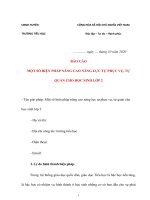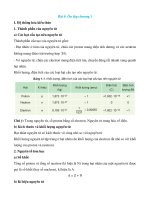2 drhue vdd mạn do hp 2eng ebmt 251116
Bạn đang xem bản rút gọn của tài liệu. Xem và tải ngay bản đầy đủ của tài liệu tại đây (670.43 KB, 29 trang )
EFFICACY OF THE BISMUTH-CONTAINING
QUADRUPLE REGIMEN (EBMT)
in patients with H. pylori- related chronic gastritis
Dang Ngoc Quy Hue
Tran Van Huy
Nguyen Thanh Hai
Hue Univesity of Medicine and Pharmacy
ThongNhat – DongNai General Hospital
1
CONTENT
1. BACKGROUND
2. AIMS
3. SUBJECTS AND METHODS
4. RESULTS - DISCUSSION
5. CONCLUSION - SUGGESTION
2
1.BACKGROUND
• H. pylori- related chromic gastritis the strongest risk
factor for gastric cancer.
Maastricht IV & V: eradication of H. pylori =
primary prevention of GC.
Challenges: +++
• increased quickly rate of resistance of H. pylori
• Correa, P. (1992) . Cancer research 52: 6735-6740.
• Fallone, C. A., et al (2016), The Toronto Consensus for the Treatment of Helicobacter pylori Infection in Adults, Gastroenterology.
3
• Malfertheiner, P., et al (2012, 2016), Management of Helicobacter pylori infection--the Maastricht IV, V. Gut.
1.BACKGROUND
Resistant rate (%)
Author
Resistance
Year
CLR
Bình T.T
LFX
MTZ
2008
33.0
18.4
69.9
Phan Trung
Nam
2012-2013
42.9
30.2
84.6
44.6
39.5
61.5
Đặng Ngọc
Quý Huệ
2013
71.6
64.1
30.6
29.2
TET
AMX
≥2
ABX
CLR+MTZ
24.3
5.8
0.0
67.9
67.4
69.2
-
1.8
0.0
7.7
2 abx 45.6
-
-
-
CLR+LFX
22.4
4
1.BACKGROUND
• Maastricht IV (2012), V (2016), Toronto (2016):
bismuth – containing quadruple therapy (PBMT)
first-line empirical treatment and
after the first eradication failure.
• Data about eradication rates of PBMT in
Vietnam: still limited
• Fallone, C. A., et al (2016), The Toronto Consensus for the Treatment of Helicobacter pylori Infection in Adults, Gastroenterology.
5
• Malfertheiner, P., et al (2012, 2016), Management of Helicobacter pylori infection--the Maastricht IV, V. Gut.
2. AIMS
To evaluate Helicobacter pylori eradication rate
To determine the rate of side effects
To access the rate of medication compliance.
of bismuth-containing quadruple regimen (EBMT) in patients
with
chronic gastritis H. pylori (+)
6
3.SUBJECTS AND METHODS
• STUDY DESIGN
Prospective, uncontrolled clinical trial.
• POPULATION
Outpatient with gastroduodenal disease
followed up at Gastroenterology clinics, in
Thong Nhat – Dong Nai General Hospital.
7
3.PATIENTS
• INCLUSION CRITERIA
Signs, symptoms of gastroduodenal disease.
Endoscopy: purely gastritis.
Histology: chronic gastritis.
Diagnosis in H. pylori infected by ≥ 2 tests (+):
RUT (+) +
100%
1/3
- Antrum biopsy specimen
- Corpus biopsy specimen
H. pylori (+)
- Culture
8
3.PATIENTS
• EXCLUSION CRITERIA
Used: Antibiotics, Bismuth < 4 wks; anti-secretory agents < 2 wks
Medical history: Coagulation disorders, allergy to any drugs.
Chronic disease: heart failure, renal failure, cirrhosis, chronic pulmonary
disease.
Laboratory test:
PLT < 100 K/L
ALT > 60UI/L (male), > 38 UI/L (female).
Gastric histopathology with cancer cells.
9
3. ERADICATION REGIMEN
• ERADICATION REGIMEN EBMT 10 days:
Esomeprazol 40 mg, b.i.d; 30 mins before meal
Tripotassium dicitrato Bismuthate 600 mg, b.i.d;
30 mins before meal
Metronidazole 250 mg, q.i.d
Tetracycline 500 mg, q.i.d.
10
3.FOLLOW – UP
• EVALUATE MEDICATION COMPLIANCE AND SIDE EFFECTS, DAY 1-14:
follow – up side effects of therapy
patient compliance
patient taking rightly, using ≥ 80% delivered - drugs.
degree of compliance:
- Low level compliance: ≥ 80-90%
- High level compliance: ≥ 91-100% (completely 100%).
11
3.FOLLOW – UP
• ASSESSMENT METHODS OF ERADICATION, WEEK 4 – 8 AFTER
STOPPING TREATMENT COURSE:
Repeat endoscopy with both tests:
RUT
Histological examination
Successful eradication of H. pylori = ALL of three tests (-):
RUT (-) + corpus biopsy (-) + antrum biopsy (-).
12
177 patient
Agreed to participate in the
study
8 patients excluded:
-7 pts ALT > 2 times ULN
-1 pts PLT <100 K/L
169 patient
Treatment EBMT D1-D10
FLOW – CHART
OF THE STUDY
3 patients excluded:
lost to follow-up
16 patients excluded :
-3 side effects
-1 unrelieved disease
-2 compliance <80%
-3 no endoscopy
-1 test H. pylori another
hospital
-1 used antibiotic for
different disease
-1 took more drugs at
day2 due to fever
-3 got out of the area
-1 lost to follow-up
ITT
PP
166 patient
Have information after
≥ 1 dose of treatment
150 patient
Complete research
Success rate
of
eradication
Failure rate
of
eradication
D11-D14: Evaluate
side effects, and
medication compliance
D40-D56 (Week 4–8
after stopping
treatment course):
Repeat endoscopy
13
4.RESULTS - DISCUSSION
From 3/2014 to 1/2016: 166 patients
Mean age ± SD:
38.70 ± 10.47
•Minimum: 17
•Maximum: 73
14
4.DEMOGRAPHIC VARIABLES
Mean age
Female (%)
Dore [1]
52
62.33
Laine [2]
47±13
38
Malfertheiner [3]
48.53±14.64
48
Our study
38.70± 10.47
42.77
Author
• Our study: purely chronic gastritis, included naïve
patients or after ≥ one eradication failure.
• Other studies: imflammation, ulcers and other
gastroduodenal disease, nạve patients.
(1) Dore, M. P., et al. (2011), Helicobacter, 16(4), pp.295-300
(2) Laine, L., et al (2003), Am J Gastroenterol, 98(3), pp.562-567.
(3) Malfertheiner, P., (2011), Lancet, 377(9769), pp.905-913.
15
4.HISTORY OF TREATMEN H. PYLORI
16
4.SUCCESSFUL OF H. PYLORI
ERADICATION
RATE
RESULTS OF H. PYLORI ERADICATION
POPULATION
ITT (n = 166)
PP (n = 150)
Cases (%)
CI 95%
Cases (%)
CI 95%
Overall
134 (80.72)
73.89 – 86.43
134 (89.33)
83.26 – 93.78
Naïve patients
97 (79.51)
71.25 – 86.28
97 (90.65)
83.48 – 95.43
22 (91.67)
73.00 – 98.97
22 (91.67)
73.00 – 98.97
15 (75.00)
50.90 – 91.34
15 (78.95)
54.43 – 93.95
After 1st eradication
failure
After ≥ 2 eradication
failures
17
4.RATE OF FIRST H.PYLORI ERADICATION
NAÏVE PATIENTS
RESULTS OF H. PYLORI ERADICATION
Author
ITT (%)
PP (%)
Dore [1]
92
95
Laine [2]
87.7
92.5
94
98
79.51
90.65
O’Morain [3]
Our study
•Don’t know clearly the importance of H. pylori eradication.
•Be afraid of endoscopy after H. pylori treatment.
•Choose urea breath test
(1) Dore, M. P., et al. (2011), Helicobacter, 16(4), pp.295-300
(2) Laine, L., et al (2003), Am J Gastroenterol, 98(3), pp.562-567.
(3) O'Morain, et al (2003), Aliment Pharmacol Ther, 17(3), pp.415-420.
18
4.RATE OF H. PYLORI ERADICATION
AFTER 1ST ERADICATION FAILURE
Author
RESULTS OF H. PYLORI ERADICATION
ITT (%)
PP (%)
T. T. Trung [1]
93.3
95.7
Kuo [2]
79.7
90.8
91.67
91.67
Our study
•Successful eradication: T. T. Trung > Our study > Kuo
•Result of Kuo’s study after 1st eradication failure (ITT 79.7 and
PP 90.8%) is the same as the first eradication result in our study
(79.51 and 90.65%) given up treament
(1) Trần Thiện Trung (2009), Y học Tp. Hồ Chí Minh, 13(Phụ bản số 1), tr.11-17.
(2) Kuo, C. H., et al (2013), J Antimicrob Chemother, 68(1), pp.222-228
19
4.RATE OF H. PYLORI ERADICATION
AFTER ≥ 2 ERADICATION FAILURES
Author
Gisbert
Our study
RESULTS OF H. PYLORI ERADICATION
ITT (%)
PP (%)
65
67
75.00
78.95
•Gisbert:
•Treatment duration varied from 7 to 14 days.
•Variable doses of Tetracycline và Metronidazole.
(1) Gisbert, J. P., (2014), Dig Dis Sci, 59(2), pp.383-389
20


